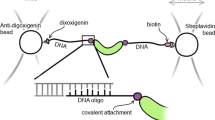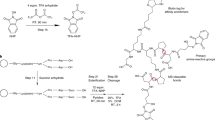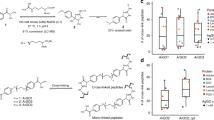Abstract
Understanding how proteins and materials interact is useful for evaluating the safety of biomedical micro/nanomaterials, toxicity estimation and design of nano-drugs and catalytic activity improvement of bio-inorganic functional hybrids. However, characterizing the interfacial molecular details of protein-micro/nanomaterial hybrids remains a great challenge. This protocol describes the lysine reactivity profiling-mass spectrometry strategy for determining which parts of a protein are interacting with the micro/nanomaterials. Lysine residues occur frequently on hydrophilic protein surfaces, and their reactivity is dependent on the accessibility of their amine groups. The accessibility of a lysine residue is lower when it is in contact with another object; allosteric effects resulting from this interaction might reduce or increase the reactivity of remote lysine residues. Lysine reactivity is therefore a useful indicator of protein localization orientation, interaction sequence regions, binding sites and modulated protein structures in the protein-material hybrids. We describe the optimized two-step isotope dimethyl labeling strategy for protein-material hybrids under their native and denaturing conditions in sequence. The comparative quantification results of lysine reactivity are only dependent on the native microenvironments of lysine local structures. We also highlight other critical steps including protein digestion, elution from materials, data processing and interfacial structure analysis. The two-step isotope labeling steps need ~5 h, and the whole protocol including digestion, liquid chromatography-tandem mass spectrometry, data processing and structure analysis needs ~3–5 d.
Key points
-
Lysine residues occur frequently on hydrophilic protein surfaces. The reactivity of lysine residues to dimethylation depends on their accessibility. Reaction conditions can be optimized such that the heterogeneity of lysine reactivity is reflected by labeling efficiency.
-
In combination with mass spectrometry, this approach—lysine residue profiling-mass spectrometry—can be used to determine interfacial molecular details for protein-protein and protein-material complexes.
This is a preview of subscription content, access via your institution
Access options
Access Nature and 54 other Nature Portfolio journals
Get Nature+, our best-value online-access subscription
$29.99 / 30 days
cancel any time
Subscribe to this journal
Receive 12 print issues and online access
$259.00 per year
only $21.58 per issue
Buy this article
- Purchase on Springer Link
- Instant access to full article PDF
Prices may be subject to local taxes which are calculated during checkout






Similar content being viewed by others
Data availability
The key data used in this protocol as examples or anticipated results are available within the paper and at https://doi.org/10.5281/zenodo.7697479. All relevant figures are available within the paper and at https://doi.org/10.6084/m9.figshare.22199440. Any additional data that supports the findings can be provided from the corresponding author upon request.
References
Tsapikouni, T. S. & Missirlis, Y. F. Protein–material interactions: from micro-to-nano scale. Mater. Sci. Eng. B 152, 2–7 (2008).
Park, S. & Hamad-Schifferli, K. Nanoscale interfaces to biology. Curr. Opin. Chem. Biol. 14, 616–622 (2010).
Wang, Y., Cai, R. & Chen, C. The nano–bio interactions of nanomedicines: understanding the biochemical driving forces and redox reactions. Acc. Chem. Res. 52, 1507–1518 (2019).
Wang, J., Quershi, W. A., Li, Y., Xu, J. & Nie, G. Analytical methods for nano-bio interface interactions. Sci. China Chem. 59, 1467–1478 (2016).
Wang, X. et al. Probing adsorption behaviors of BSA onto chiral surfaces of nanoparticles. Small 14, e1703982 (2018).
Pastore, C. Size-dependent nano–bio interactions. Nat. Nanotechnol. 16, 1052 (2021).
Yu, L. et al. Highly efficient artificial blood coagulation shortcut confined on Ca-zeolite surface. Nano Res. 14, 3309–3318 (2021).
He, M. et al. The interfacial interactions of nanomaterials with human serum albumin. Anal. Bioanal. Chem. 414, 4677–4684 (2022).
Zhang, G. et al. A nanomaterial targeting the spike protein captures SARS-CoV-2 variants and promotes viral elimination. Nat. Nanotechnol. 17, 993–1003 (2022).
Shang, X. et al. Unusual zymogen activation patterns in the protein corona of Ca-zeolites. Nat. Catal. 4, 607–614 (2021).
He, M. et al. Characterization and manipulation of the photosystem II-semiconductor interfacial molecular interactions in solar-to-chemical energy conversion. J. Energy Chem. 70, 437–443 (2022).
Echols, N. et al. Comprehensive analysis of amino acid and nucleotide composition in eukaryotic genomes, comparing genes and pseudogenes. Nucleic Acids Res. 30, 2515–2523 (2002).
Matos, M. J. et al. Chemo- and regioselective lysine modification on native proteins. J. Am. Chem. Soc. 140, 4004–4017 (2018).
Liu, X., Salokas, K., Weldatsadik, R. G., Gawriyski, L. & Varjosalo, M. Combined proximity labeling and affinity purification−mass spectrometry workflow for mapping and visualizing protein interaction networks. Nat. Protoc. 15, 3182–3211 (2020).
Hanai, R. & Wang, J. C. Protein footprinting by the combined use of reversible and irreversible lysine modifications. Proc. Natl Acad. Sci. USA 91, 11904–11908 (1994).
Leitner, A. A review of the role of chemical modification methods in contemporary mass spectrometry-based proteomics research. Anal. Chim. Acta 1000, 2–19 (2018).
Zhou, Y. & Vachet, R. W. Covalent labeling with isotopically encoded reagents for faster structural analysis of proteins by mass spectrometry. Anal. Chem. 85, 9664–9670 (2013).
Hitchcock-De Gregori, S. E. Study of the structure of troponin-I by measuring the relative reactivities of lysines with acetic anhydride. J. Biol. Chem. 257, 7372–7380 (1982).
Scholten, A., Visser, N. F. C., van den Heuvel, R. H. H. & Heck, A. J. R. Analysis of protein-protein interaction surfaces using a combination of efficient lysine acetylation and nanoLC-MALDI-MS/MS applied to the E9:Im9 bacteriotoxin–immunity protein complex. J. Am. Soc. Mass Spectrom. 17, 983–994 (2006).
Liu, Z. et al. Reductive methylation labeling, from quantitative to structural proteomics. Trends Anal. Chem. 118, 771–778 (2019).
Boersema, P. J., Raijmakers, R., Lemeer, S., Mohammed, S. & Heck, A. J. R. Multiplex peptide stable isotope dimethyl labeling for quantitative proteomics. Nat. Protoc. 4, 484–494 (2009).
Zhou, Y. et al. Probing the lysine proximal microenvironments within membrane protein complexes by active dimethyl labeling and mass spectrometry. Anal. Chem. 88, 12060–12065 (2016).
Chen, J. et al. Quantitative lysine reactivity profiling reveals conformational inhibition dynamics and potency of Aurora A kinase inhibitors. Anal. Chem. 91, 13222–13229 (2019).
Chen, T.-R. et al. Biflavones from Ginkgo biloba as inhibitors of human thrombin. Bioorg. Chem. 92, 103199 (2019).
Zhou, Y. et al. Prediction of ligand modulation patterns on membrane receptors via lysine reactivity profiling. Chem. Comm. 55, 4311–4314 (2019).
Liu, Z. et al. Probing conformational hotspots for the recognition and intervention of protein complexes by lysine reactivity profiling. Chem. Sci. 12, 1451–1457 (2021).
Zhang, W. et al. Elucidating the molecular mechanisms of perfluorooctanoic acid-serum protein interactions by structural mass spectrometry. Chemosphere 291, 132945 (2022).
Ma, R. et al. Emerging investigator series: long-term exposure of amorphous silica nanoparticles disrupts the lysosomal and cholesterol homeostasis in macrophages. Environ. Sci. Nano 9, 105–117 (2022).
Cao, J. et al. Coronas of micro/nano plastics: a key determinant in their risk assessments. Part. Fibre Toxicol. 19, 55 (2022).
Yang, S. et al. Lysine reactivity profiling reveals molecular insights into human serum albumin–small-molecule drug interactions. Anal. Bioanal. Chem. 413, 7431–7440 (2021).
Wang, L. et al. Revealing the binding structure of the protein corona on gold nanorods using synchrotron radiation-based techniques: understanding the reduced damage in cell membranes. J. Am. Chem. Soc. 135, 17359–17368 (2013).
Lai, Z. W., Yan, Y., Caruso, F. & Nice, E. C. Emerging techniques in proteomics for probing nano–bio interactions. ACS Nano 6, 10438–10448 (2012).
Baimanov, D., Cai, R. & Chen, C. Understanding the chemical nature of nanoparticle–protein interactions. Bioconjug. Chem. 30, 1923–1937 (2019).
Cedervall, T. et al. Detailed identification of plasma proteins adsorbed on copolymer nanoparticles. Angew. Chem. Int. Ed. Engl. 46, 5754–5756 (2007).
Cai, R. et al. Dynamic intracellular exchange of nanomaterials’ protein corona perturbs proteostasis and remodels cell metabolism. Proc. Natl Acad. Sci. USA 119, e2200363119 (2022).
Acknowledgements
We acknowledge financial support from the National Key R&D Program of China (2022YFC3400502), the National Natural Science Foundation of China (32088101, 22288201, 92253304 and 22204165) and grants from DICP (DICPI202242). The authors acknowledge the technological support of the biological mass spectrometry station of the Dalian Coherent Light Source.
Author information
Authors and Affiliations
Contributions
Z.L., S.Y., L.Z. and F.W. developed the protocol and wrote the manuscript. M.H. and Y.B. optimized the protocol. S.Z. contributed to the manuscript modification.
Corresponding author
Ethics declarations
Competing interests
The authors declare no competing interests.
Peer review
Peer review information
Nature Protocols thanks Junfeng Ma and the other, anonymous, reviewer(s) for their contribution.
Additional information
Publisher’s note Springer Nature remains neutral with regard to jurisdictional claims in published maps and institutional affiliations.
Related links
Key references using this protocol
He, M. et al. J. Energy Chem. 70, 437–443 (2022): https://doi.org/10.1016/j.jechem.2022.03.002
Shang, X. et al. Nat. Catal. 4, 607–614 (2021): https://doi.org/10.1038/s41929-021-00654-6
Zhang, G. et al. Nat. Nanotechnol. 17, 993–1003 (2022): https://doi.org/10.1038/s41565-022-01177-2
Rights and permissions
Springer Nature or its licensor (e.g. a society or other partner) holds exclusive rights to this article under a publishing agreement with the author(s) or other rightsholder(s); author self-archiving of the accepted manuscript version of this article is solely governed by the terms of such publishing agreement and applicable law.
About this article
Cite this article
Liu, Z., Yang, S., Zhou, L. et al. Structural characterization of protein-material interfacial interactions using lysine reactivity profiling-mass spectrometry. Nat Protoc 18, 2600–2623 (2023). https://doi.org/10.1038/s41596-023-00849-0
Received:
Accepted:
Published:
Issue Date:
DOI: https://doi.org/10.1038/s41596-023-00849-0
Comments
By submitting a comment you agree to abide by our Terms and Community Guidelines. If you find something abusive or that does not comply with our terms or guidelines please flag it as inappropriate.



